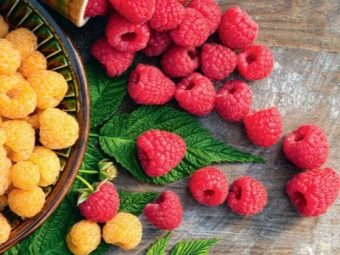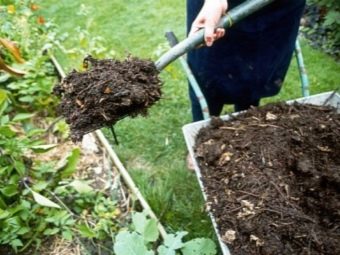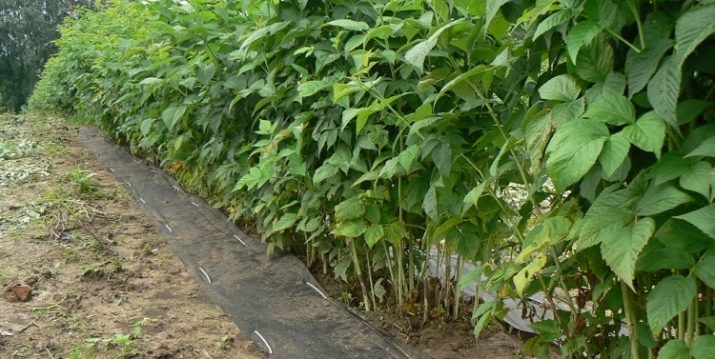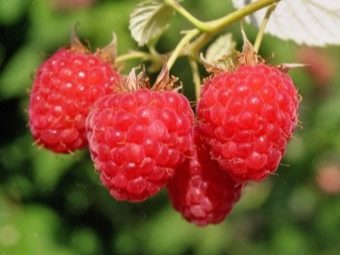What is the yield of raspberries with 1 ha and how to increase it?

Without a doubt, everyone recognizes the aroma, juiciness and usefulness of raspberries (berries and leaves contain many vitamins and even trace elements). It is difficult to deny yourself a cup of tea with raspberry homemade jam or jam on a frosty winter evening, and even more so during colds. Today, perhaps, every second owner of a personal garden plot grows raspberries. And everyone wants to take a bigger harvest, knowing at the same time that it will have to spend a lot of effort. It should understand the issues of yield of raspberries, the choice of suitable varieties.
Features increase in yield
The yield of raspberries depends on several parameters: the yield of the variety, the area of plantings and the number of seedlings in this area, the characteristics of the gardener's living area (in some regions only in greenhouse conditions the risk of crop loss can be significantly reduced) this locality. Depending on whether raspberries are grown for personal consumption or production on an industrial scale, you can harvest from 3–7 kg per bush to 8–20 tons per hectare.
How to achieve such results or even exceed them by several times: study the advice of experts and follow them (from choosing the best varieties to agricultural technology), do not neglect the care of delicate raspberries. Particular attention should be paid to the recommendations of experts raspberry nurseries, adopting their "tricks" to increase yields.
At the cottage of two summer residents placed a different amount of raspberry. It will not be the same if one of them follows the recommendations of specialists and can increase the yield from 1 hectare.
Five tips from professionals
It is not necessary to plant everything. Greater results can be achieved if a responsible approach to the choice of crop varieties. In order to harvest a good raspberry crop, it is necessary to strictly follow the agrotechnical requirements, but taking into account the difference in the agrotechnology of planting and care for ordinary varieties and remontants. Compliance with the requirements in the complex allows you to grow bushes with high yields.
Responsible attitude to the choice of variety
To choose the right variety, you should pay attention to the following recommendations:
- saplings of large-fruited varieties should be chosen (the weight of the berry is 5–12 g);
- if harvest is planned during the whole season, varieties with different ripening periods should be selected, taking into account the climatic conditions of the growing region, the crop can be harvested from spring to late autumn;
- in the characteristics of the variety, special attention must be paid to the preservation of the berries on the bush, because the preservation of the berries on the hand during ripening and its resistance to rotting depends on this.
Compliance with the rules and techniques of agricultural engineering
Regardless of which sort of berries is chosen, you need to remember a few rules, compliance with which will significantly increase the yield of raspberries, such as:
- elimination of weeds in places where raspberries grow;
- the plant prefers lit areas or partial shade;
- timely collection of ripe berries will prevent the spread of disease;
- watering is abundant, but infrequent in order to avoid root rot;
- changing the location of the raspberries one time in 10–15 years, during this period the soil is fairly depleted, which leads to a decrease in yield;
- preparation for the "wintering":
- removal of all leaves from the bushes in October, after the harvest and before the first frost;
- green and slightly lignified shoots, some experts recommend to bend down to the ground, crushing it with some heavy object, but not with bricks, and in no case sprinkling with soil;
- the thickness of the snow layer over such shoots must be at least half a meter.
Planting and caring for raspberries common varieties include the following:
- planting scheme for seedlings: 1 m of free space between row bushes, distance between rows 1.5–2 m;
- planting time - spring or early autumn;
- timely removal of shoots.Thickening is unacceptable, raspberries love to be aired and does not like strong shading;
- pruning is recommended in the fall at the root, after treating the cut;
- top dressing with fertilizers twice per season (organic matter - manure, nitrogen fertilizers and potash compounds);
- the use of chemistry in pest control and for protection against diseases strictly before flowering begins (there must be visible reasons for processing);
- it is desirable to choose for planting varieties with high resistance to various diseases;
- watering as necessary, special attention should be paid to watering in seasons with a long absence of precipitation;
- in order to avoid excessive moisture loss, after watering and easy soil loosening (5–7 cm depth), raspberries should be mulched with humus and dry grass, such as hay or straw.
The period of fruiting remontantny varieties occurs from summer to autumn, they can produce a crop in the first year. When planting and caring for raspberries should follow the following recommendations:
- planting scheme of saplings: 70–75 cm between saplings, inter-row spacing - 1–1.5 m. These raspberry varieties have a smaller number of shoots formed near the main stalk;
- planting time - in the middle of autumn (from the first week of October), but before the onset of the first frost;
- cuttings in the spring only after the emergence of future branches of substitution (these varieties of raspberries have few additional shoots), so the bushes will easily endure the winter. Fruiting young shoots in remontant varieties comes in the second year;
- the introduction of organic matter, for example, manure or a mixture of: humus, superphosphate and potassium in the spring and at the time of flowering according to the scheme: 0.5 tons per hundred, while abundant watering of the bushes;
- mulch, as for ordinary varieties, will provide the necessary soil moisture and help keep the roots from freezing during the winter cold season.
Correct and timely pruning bushes
As a rule, when cutting raspberry bushes, they use the method of gardener-experienced Sobolev (a double pruning method). Thanks to this method of trimming the bush is significantly rejuvenated, which leads to an increase in the number of berries in the current season. To prolong the life of the bushes will allow and timely pruning of old and "sick" stems. Productivity and preservation increases shortening of shoots of replacement.
It is important to use a sharp and serviceable tool when trimming.
"Right" soil for raspberries
The soil for planting is recommended to prepare in advance. Raspberries do not like strongly acidic soils, on them it is poorly acclimatized and has a low yield. It is desirable, cultivating the soil under the raspberry, take into account that the acidity (ph) should not exceed 6.2 units. Another mandatory requirement for soil is enrichment with organic matter. The composition of the soil: humus - 2 buckets, superphosphate - 200 g, potash salt - 80 g per 1 m².
Some gardeners replace potash with wood ash - 0.5 kg per 1 m². For fertilizing the soil in the spring it is recommended to use carbamide (urea) - 100 g per 1 m².
Necessary and the correct strait of soil. For the productivity of raspberries the soil moisture should be no less than 10 cm. Therefore, it is worth plentifully shed raspberries if precipitation is rare or absent for a long time.
Choosing the "right" seedlings and preventive measures
One of the main ways to increase the yield of raspberries is to choose the optimal variety. It is important to acquire healthy planting material. To purchase seedlings use proven nurseries. But it should be borne in mind that grown in greenhouse conditions for the purpose of selling a sapling can be very expensive. But then experienced nursery specialists will give recommendations on growing the raspberry variety selected for purchase. It may be the bushes from the "generous" neighbor in the area. But it’s not enough, just choose a raspberry variety that is productive and suitable for the breeding area.
The yield of each bush depends on the health of seedlings. When choosing seedlings should pay attention to the root system. The stem cut should be green, approximately 1 cm in diameter. Before planting, the seedlings should be decontaminated in a weak manganese solution. It is necessary to arm yourself with a directory of means to combat a number of diseases of berry crops, as well as to combat the invasion of insect pests. The use of knowledge about the prevention of plant diseases leads to an increase in yield at the site.
It is advisable to choose varieties with different ripening. This will not only allow harvesting during the whole season under favorable conditions, but in principle, its availability, since different varieties are prone to different diseases.
It should be borne in mind that, ideally, you should not plant plants with different maturity interspersed. Best of all, if it is done in rows. This facilitates the processing of the bushes, and the harvest. Compliance with even such simple tips will allow you to get more berries from each section of the bush, which means not only enjoy the taste of fragrant berries, but also treat your relatives and “generous” neighbors with it, if he doesn’t work well with the harvest.
Popular remontant varieties
Today there are several famous remontant raspberry varieties.
- "Apricot" - This is a high-yielding variety. Although the berry is not very large (3.5–4.2 g), but very fragrant and tasty. Harvest with the observance of agricultural technology can be obtained until mid-October.
- "Brusvian" - it is an early ripe grade. Productivity makes up to 8 kg from a bush. The berry is large - up to 15 g. When it reaches a height of 2 m, it does not need a garter.
- Yellow Giant has a yield of 12-15 kg per season. He is a champion among the varieties of yellow raspberries, as the berry is large - 12 g. Gardeners note the taste of the berries.
- "Polka" - this is not the most fruitful variety, because you can collect up to 3.5 kg from a bush, but its berries are of very high quality. The weight of the berry is 10 g. The variety is characterized by transportability. It has a long fruiting period. Bush srednerosly with an abundance of lateral shoots.
- "Pringvin-2" - This is a high-yielding variety. With good care from the bush you can get up to 15 kg of the crop. In height it reaches 1.3 m.
- "Shugana" - This is a relatively new Swiss variety. The average yield is 9 kg. Berries are large and very tasty.
- "Yaroslavna" - It is a representative of high-yielding varieties of yellow raspberry. According to its properties, it has a lot in common with the “Brusivany” variety.
In the next video you are waiting for 9 secrets of a large crop of raspberries.


































